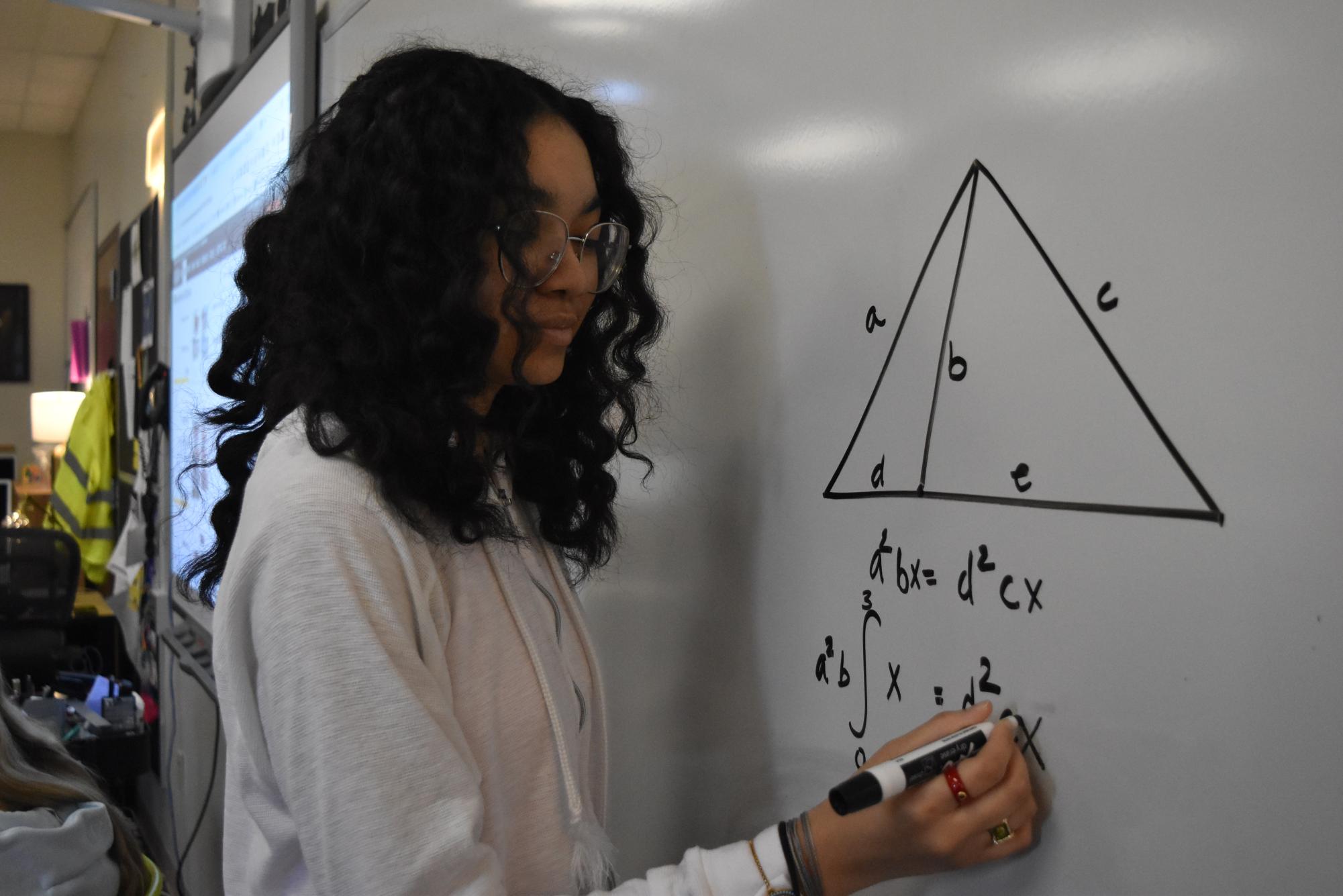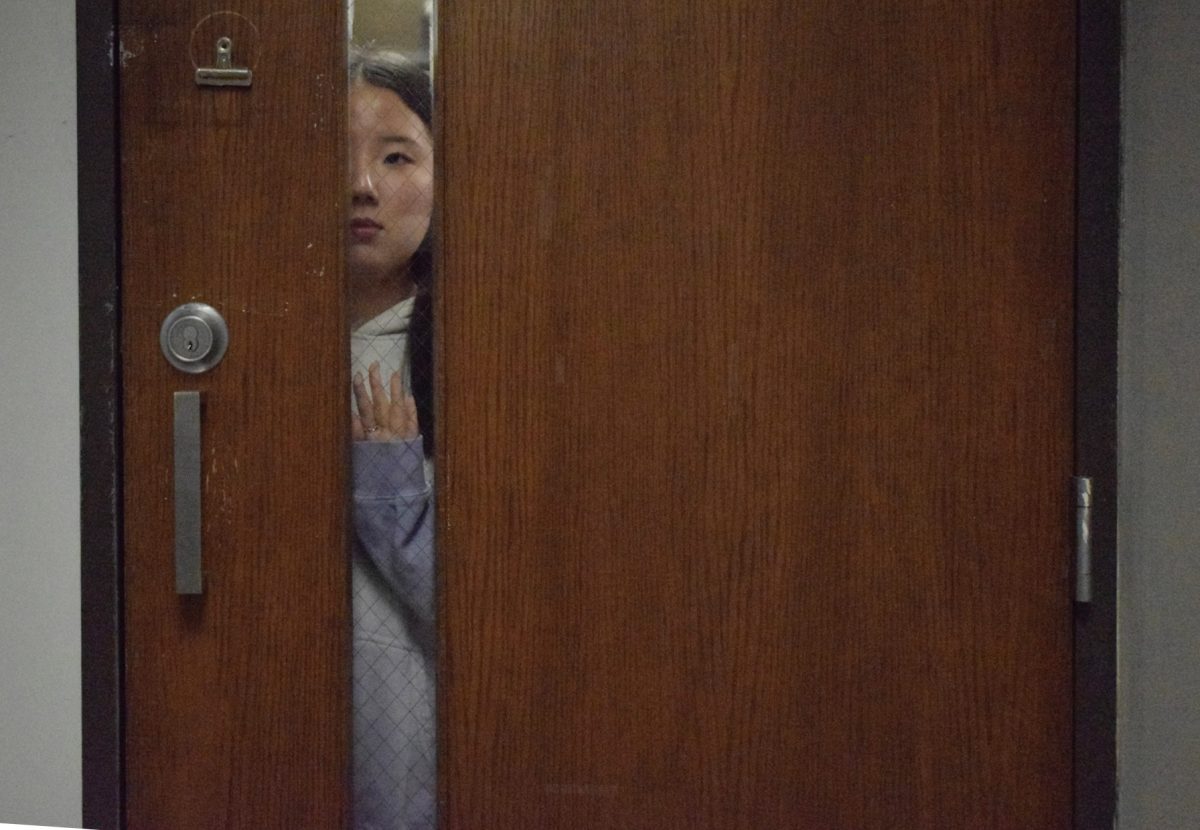Thirty thousand students in the United States participate annually in the American Mathematics Competition, an exam that allows students to potentially represent the U.S. in the International Math Olympiad. Yet, only 14% of those students identify as girls, and a smaller proportion make it to the top ranks.
While at first glance, this may appear to be solely a participation issue, the lack of girls pursuing competitive math, especially in school, can lead to math anxiety. This problem leads to diminishing performance and engagement in advanced and competitive math. Multiple studies have found that by third grade, many girls lose confidence in math, which leads to a gendered math gap where, in higher-income households, boys tend to score higher in math than girls, and in lower-income households, girls perform better but only by a small percentage.┬Ā
ŌĆ£I think it’s a deep-rooted opinion in our society that women aren’t as capable in STEM fields. This is a sad reality, even given that my grandmother was one of two women who graduated with a degree in chemistry the year she graduated,ŌĆØ assistant math department head and Math Contest Program leader Patrick Mooney said.┬Ā
One of the most common reasons why many girls tend to lose interest in math early on is because of the myth of the ŌĆ£math brainŌĆØ: boys tend to be more logical and better fit for STEM fields, while women tend to be more emotional, better fit for the arts and humanities. Yet, research shows no innate cognitive biological differences between men and women in math. This makes sense evolutionarily õĖĆ why should women, who often become mothers and have the responsibility of carrying the child, be less logical than their male counterparts?┬Ā
Freshman Alisha Yin has been involved in science competitions, like Science Bowl and math contests, like the American Math Competition (AMC) series and MCTM since the fifth grade.┬Ā
ŌĆ£A lot of people claim thereŌĆÖs ŌĆśequal opportunityŌĆÖ for women to participate in math contests or pursue STEM and that they are not doing it simply because they are not inclined. But thatŌĆÖs not the case at all,ŌĆØ Yin said. ŌĆ£From my experience, a lot of girls have a lot of interest in these subjects and especially in competing in STEM subjects. But, they end up not pursuing them or working as hard in them because, for young girls, there isnŌĆÖt as strong of a pre-established culture around it, as young boys [have]. So, as a girl, you have to implement yourself harder to see yourself in the same dreams the boys your age have.ŌĆØ┬Ā
In competitive math, where competitions often require students to work in teams, young girls can feel alienated from their male peers. Not only can this lead to a future lack of participation in math competitions, but it can also discourage girls from continuing to improve their competition math skills.┬Ā
ŌĆ£When I was younger, math was a huge part of my life, with studying for contests like Mathcounts and MathLeague taking up large portions of my time,ŌĆØ Yin said. ŌĆ£But slowly, as less and less of my friends were doing these contests with me, I lost motivation. I had friends who were guys, but it just wasnŌĆÖt the same because they would obviously be closer with their other male friends.ŌĆØ
In addition, due to the lack of participation, there are going to be fewer performing well enough to qualify for selective math exams like the American Invitation Math Examination or International Math Olympiad, leading to less representation, which can, in turn, demotivate younger girls from participating in the preliminary stages that can lead them to such paths.┬Ā
ŌĆ£In the whole middle school math team, with 14 people, I would be the only girl. And then when IŌĆÖd go on stage, to receive awards for being top 10 or top five, IŌĆÖd be the only girl up there, which was pretty alienating,ŌĆØ Yin said. ŌĆ£I remember in fifth or sixth grade I got first in the state in the Countdown round of the MathCounts competition. Afterwards, a lot of people were saying it was easier for me to get first because I was a girl, and the competition managers ŌĆśwent easier.ŌĆÖ But, that was literally not the case because all the questions are the same difficulty and randomly generated. ItŌĆÖs little comments like this that make a big difference in a girlŌĆÖs motivation to not only participate in math contests but actually study and work for excelling in them.ŌĆØ
Ultimately, employees in the STEM field earn two-thirds more than those employed in other fields, according to the Pew Research Center. And, a direct pipeline to the highest-paying jobs in the STEM field, like quantitative traders and software engineers, is competitive math. So, the gender gap in competition math can actually lead to a lack of monetary independence in women, further perpetuating gender stereotypes.
ŌĆ£I think the more we encourage the analytical intelligence of women, it will decrease the gender gaps in the field. In other words, showing girls they can do STEM now will make it easier to keep them doing it in the future,ŌĆØ Mooney said. ŌĆ£We need to show the student population that it is fun to challenge ourselves every once in a while.ŌĆØ
Male-dominated competition in math environments leads to male-dominated industries in highly lucrative careers. But, itŌĆÖs time to turn this gender gap into a bridge, where everyone works to incorporate diversity and meritocracy in a high-achieving academic environment. ItŌĆÖs not just about promoting participation to meet diversity quotas; itŌĆÖs about promoting the idea that girls can succeed in a competitive, cutthroat environment and win.
Interested in STEM or just want to try something new, here are some math competitions to get started with:
- American Math Competition: Scoring well on this multiple-choice exam allows you to qualify for the American Invitational Math Exam, and if you perform well on the AIME, you qualify for the US(J)AMO which is the national math olympiad. In addition, the Mathematical Association of America, the organization that hosts the AMC and AIME, recognizes young girls who perform well on the AMC with prizes like the Maryam Mirzakhani, Akamai and Jane Street awards. West High hosts the AMC 10 and 12, reach out to Mooney if interested.
- INTEGIRLS Math Contest: INTEGIRLS is a nonprofit organization that has chapters in multiple states õĖĆ┬Ā including a chapter in St. Louis õĖĆ that hosts math competitions for young girls interested in math. INTEGIRLS STL hosts biannual math contests that are completely free to sign up for, with the next one taking place online in March 2024.┬Ā
- Atlantic Pacific Math Contest (At-Pac): This is a series of six contests given monthly from November to April, with topics ranging from geometry to combinatorics. West High hosts the At-Pac, reach out to Mooney if interested.
- MathLeague Contests: MathLeague is an organization that hosts math competitions, both online and in person. They have multiple regional qualifying events. Students who score well enough are invited to the State, National or International Championships. Check for events near you, and sign up independently.




![Sitting courtside before a junior varsity girlsŌĆÖ tennis match, senior Tanisi Saha rushes to finish her homework. Saha has found herself doing academic work during her athletic activities since her freshman year. ŌĆ£Being in sports has taught me how to stay organized and on top of my schoolwork. [With] a busy practice and game schedule, IŌĆÖve learned to manage my homework and study time better,ŌĆØ Saha said.](https://pwestpathfinder.com/wp-content/uploads/2025/11/DSC_0022-1200x800.jpg)
![Sophomore Maryem Hidic signs up for an academic lab through Infinite Campus, a grading and scheduling software. Some students enjoyed selecting their responsive schedule in a method that was used school-wide last year. ŌĆ£I think it's more inconvenient now, because I can't change [my classes] the day of, if I have a big test coming and I forget about it, I can't change [my class],ŌĆØ sophomore Alisha Singh said.](https://pwestpathfinder.com/wp-content/uploads/2025/10/DSC_0012-1200x801.jpg)
![Senior Dhiya Prasanna examines a bottle of Tylenol. Prasanna has observed data in science labs and in real life. ŌĆ£[I] advise the public not to just look or search for information that supports your argument, but search for information that doesn't support it,ŌĆØ Prasanna said.](https://pwestpathfinder.com/wp-content/uploads/2025/10/DSC_0073-2-1200x800.jpg)
![Junior Fiona Dye lifts weights in Strength and Conditioning. Now that the Trump administration has instituted policies such as AI deregulation, tariffs and university funding freezes, women may have to work twice as hard to get half as far. "[Trump] wants America to be more divided; he wants to inspire hatred in people,ŌĆØ feminist club member and junior Clara Lazarini said.](https://pwestpathfinder.com/wp-content/uploads/2025/05/Flag.png)
![As the Trump administration cracks down on immigration, it scapegoats many immigrants for the United StatesŌĆÖ plights, precipitating a possible genocide. Sophomore Annabella Whiteley moved from the United Kingdom when she was eight. ŌĆ£ItŌĆÖs pretty scary because IŌĆÖm on a visa. When my visa expires next year, IŌĆÖm not sure whatŌĆÖs going to happen, especially with [immigration] policies up in the air, so it is a concern for my family,ŌĆØ Whiteley said.](https://pwestpathfinder.com/wp-content/uploads/2025/05/DSC_0077-7copy.jpg)
![Shifting global trade, President Donald TrumpŌĆÖs tariffs are raising concerns about economic stability for the U.S. and other countries alike. ŌĆ£[The tariffs are] going to pose a distinct challenge to the U.S. economy and a challenge to the global economy on the whole because it's going to greatly upset who trades with who and where resources and products are going to come from,ŌĆØ social studies teacher Melvin Trotier said.](https://pwestpathfinder.com/wp-content/uploads/2025/05/MDB_3456-1200x800.jpg)



![Some of the most deadly instances of gun violence have occurred in schools, communities and other ŌĆśsafe spacesŌĆÖ for students. These uncontrolled settings give way to the need for gun regulation, including background and mental health checks. ŌĆ£Gun control comes about with more laws, but there are a lot of guns out there that people could obtain illegally. What is a solution that would get the illegal guns off the street? We have yet to find [one],ŌĆØ social studies teacher Nancy Sachtlaben said.](https://pwestpathfinder.com/wp-content/uploads/2025/01/DSC_5122-1200x800.jpg)

![Sophomore Shree Sikkal Kumar serves the ball across the court in a match against Lindbergh. Sikkal Kumar has been a varsity member of the varsity girlsŌĆÖ tennis team for two years, helping her earn the number two rank in Class 2 District 2.ŌĆ£When matches are close, itŌĆÖs easy to get nervous, but I [ground] myself by[staying] confident and ready to play,ŌĆØ Sikkal Kumar said.](https://pwestpathfinder.com/wp-content/uploads/2025/11/DSC2801-1200x798.jpg)
![Dressed up as the varsity girlsŌĆÖ tennis coach Katelyn Arenos, senior Kate Johnson and junior Mireya David hand out candy at West HighŌĆÖs annual trunk or treat event. This year, the trunk or treat was moved inside as a result of adverse weather. ŌĆ£As a senior, I care less about Halloween now. Teachers will bring their kids and families [to WestŌĆÖs Trunk or Treat], but there were fewer [this year] because they just thought it was canceled [due to the] rain. [With] Halloween, I think you care less the older you get,ŌĆØ Johnson said.](https://pwestpathfinder.com/wp-content/uploads/2025/10/DSC00892-1-1200x800.jpg)
![Focused on providing exceptional service, sophomore Darsh Mahapatra carefully cleans the door of a customerŌĆÖs car. Mahapatra has always believed his customers deserve nothing less than the best. ŌĆ£[If] theyŌĆÖre trusting us with their car and our service, then I am convinced that they deserve our 100 percent effort and beyond,ŌĆØ Mahapatra said.](https://pwestpathfinder.com/wp-content/uploads/2025/10/DSC_0018-1200x800.jpg)
![Sophomore Aleix Pi de Cabanyes Navarro (left) finishes up a soccer game while junior Ava Muench (right) warms up for cross country practice. The two came to Parkway West High School as exchange students for the 2025-2026 school year. ŌĆ£The goal for the [exchange] program is to provide opportunities for both Parkway students and our international exchange students to learn about other cultures, build connections and become confident, capable, curious and caring ŌĆö ParkwayŌĆÖs Four CŌĆÖs ŌĆö in the process,ŌĆØ Exchange Program Lead Lauren Farrelly said.](https://pwestpathfinder.com/wp-content/uploads/2025/10/Feature-Photo-1200x800.png)
![Leaning on the podium, superintendent Melissa Schneider speaks to Parkway journalism students during a press conference. Schneider joined Parkway in July after working in the Thompson School District in Colorado. ŌĆ£My plan [to bond with students] is to get things on my calendar as much as possible. For example, being in [classes] is very special to me. I am trying to be opportunistic [meeting] kids [and] being in [the school] buildings. I have all the sports schedules and the fine arts schedules on my calendar, so that when I'm available, I can get to them,ŌĆØ Schneider said.](https://pwestpathfinder.com/wp-content/uploads/2025/09/IMG_5425-1200x943.jpeg)
![Gazing across the stage, sophomore Alexis Monteleone performs in the school theater. The Monteleone familyŌĆÖs band ŌĆ£Monte and the MachineŌĆØ has been releasing music since 2012, but Alexis started her own solo career in 2024 with the release of her first single, Crying Skies. ŌĆ£My whole family is very musical, [and I especially] love writing [songs with them],ŌĆØ Monteleone said.](https://pwestpathfinder.com/wp-content/uploads/2025/09/DSC7463-1200x798.jpg)

![Leaping through the air, senior Tyler Watts celebrates his first goal of the season, which put the Longhorns up 1-0 against the Lafayette Lancers. Watts decided to play soccer for West for his last year of high school and secured a spot on the varsity roster. ŌĆ£[Playing soccer for West] is something I had always dreamed of, but hadnŌĆÖt really had a good opportunity to do until now. ItŌĆÖs [really] fun being out [on the field], and IŌĆÖm glad I decided to join the team. ItŌĆÖs just all about having fun with the boys and enjoying what time we have left together,ŌĆØ Watts said.](https://pwestpathfinder.com/wp-content/uploads/2025/09/DSC_1951-1200x855.jpg)



Serena Liu • Jan 29, 2024 at 9:16 pm
Great article Audrey! See you for three hours on Thursday…
Audrey Ghosh • Feb 7, 2024 at 12:19 pm
15 questions in 3 hours is a different beast ¤Öü
Lisa Rodgers • Jan 29, 2024 at 2:27 pm
Great article! I’m an actuary at RGA Re in Chesterfield. Would be happy to chat with female math students.
– Lisa Rodgers
Emily Early • Jan 26, 2024 at 10:40 am
So amazing, Audrey!!!!!
Lauren Holcomb • Jan 23, 2024 at 8:40 pm
super interesting story audrey!!! as a humanities gal I always knew about the gender gap in stem but I had no idea how serious it was ¤Öü
Will Gonsior • Jan 23, 2024 at 12:37 pm
Great job, thank you Audrey!!!!